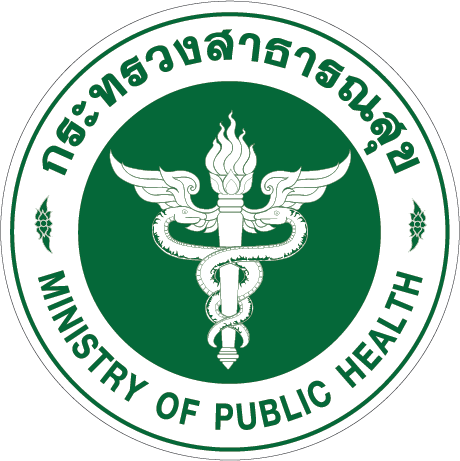Eligibility for PCSK9 Inhibitors and Associated Cost in Patient with Atherosclerotic Cardiovascular Disease at Central Chest Institute of Thailand
Keywords:
PCSK9 Inhibitors, atherosclerotic cardiovascular diseasesAbstract
Background: Proprotein convertase subtilisin kexin type 9 (PCSK9) inhibitors represent a new treatment option for lowering plasma low density lipoprotein cholesterol (LDL-C) with the benefit of reducing cardiovascular events. However, PCSK9 inhibitors are recently emerging medications with high cost.
Objective: This study aimed to assess the budgetary impact of using the PCSK9 inhibitors, evolocumab in patients with atherosclerotic cardiovascular diseases (ASCVD).
Method: Data were retrospectively reviewed in the medication records of ASCVD patients in the Central Chest Institute of Thailand during October 1st, 2019 to September 30th, 2020. Patients were followed up for a period of 1 year, then patients were divided in three groups according to their response to lipid-lowering drugs as follow: 1) all patients with LDL-C ≥70 mg/dL, 2) patients who received high intensity statin for one year and still had LDL-C ≥70 mg/dL, and 3) patients who received a high intensity statin plus ezetimibe for one year and still had LDL-C ≥70 mg/dL. The cost of using evolocumab was evaluated and compared based on the current prices in Thailand.
Results: A total of 7,491 patients with ASCVD with indications for PCSK9 inhibitors were included. The LDL-C level before starting the lipid-lowering drug was 120.13 mg/dL. After one years of follow-up, 77.79% of patients had LDL-C >70 mg/dL. Therefore, if adding evolocumab treatment in each group would require an additional drug budget as follow : group 1) 1,567-2,164 million bath/year, group 2) 885-1,222 million bath/year and group 3) 147-203 million bath/year.
Conclusion: Adding evolocumab to treatment of patients with ASCVD to reduced LDL-C to <70 mg/dL according to standard practice may increase drug budget by 147-2,164 million bath/year. If evolocumab was used only in patients who received a high intensity statin plus ezetimibe and still had LDL-C ≥70 mg/dL may reduce drug budget by 1,420-1,961 million bath/year compared with use of evolocumab in all patients with LDL-C ≥70 mg/dL.
References
Stone NJ, Robinson JG, Lichtenstein AH, Bairey Merz CN, Blum CB, Eckel RH, et al. 2013 ACC/AHA guideline on the treatment of blood cholesterol to reduce atherosclerotic cardiovascular risk in adults: a report of the American College of Cardiology/American Heart Association Task Force on Practice Guidelines. J Am Coll Cardiol. 2014;63(25 Part B):2889-934. doi: 10.1016/j.jacc.2013.11.002.
Lloyd-Jones DM, Morris PB, Ballantyne CM, Birtcher KK, Daly DD Jr, DePalma SM, et al. 2016 ACC expert consensus decision pathway on the role of non-statin therapies for LDL-cholesterol lowering in the management of atherosclerotic cardiovascular disease risk: a report of the American College of Cardiology Task Force on Clinical Expert Consensus Documents. J Am Coll Cardiol. 2016; 68(1):92-125. doi: 10.1016/j.jacc.2016.03.519.
Taylor F, Ward K, Moore TH, Burke M, Davey Smith G, Casas JP, et al. Statins for the primary prevention of cardiovascular disease. Cochrane Database Syst Rev. 2011;(1):CD004816. doi: 10.1002/14651858.CD004816.pub4.
Cholesterol Treatment Trialists' (CTT) Collaboration; Fulcher J, O'Connell R, Voysey M, Emberson J, Blackwell L, Mihaylova B, et al. Efficacy and safety of LDL-lowering therapy among men and women: meta-analysis of individual data from 174,000 participants in 27 randomised trials. Lancet. 2015;385(9976):1397-405. doi: 10.1016/S0140-6736(14)61368-4.
Cannon CP, Blazing MA, Giugliano RP, McCagg A, White JA, Theroux P, et al. Ezetimibe added to statin therapy after acute coronary syndromes. N Engl J Med. 2015;372(25):2387-97. doi: 10.1056/NEJMoa1410489.
Sabatine MS, Giugliano RP, Keech AC, Honarpour N, Wiviott SD, Murphy SA, et al. Evolocumab and clinical outcomes in patients with cardiovascular disease. N Engl J Med. 2017;376(18):1713-22. doi: 10.1056/NEJMoa1615664.
Sabatine MS, Giugliano RP, Wiviott SD, Raal FJ, Blom DJ, Robinson J, et al. Efficacy and safety of evolocumab in reducing lipids and cardiovascular events. N Engl J Med. 2015; 372(16):1500-9. doi: 10.1056/NEJMoa1500858.
Amgen Inc. REPATHA® (evolocumab) injection, for subcutaneous use. In: Drugs@FDA: FDA-Approved Drugs [Internet]. n.p.: U.S. Food and Drug Administration; 2017 [cited 2018 May 22]. Available from: https://www.accessdata.fda.gov/drugsatfda_docs/label/2021/125522orig2s000lbl.pdf
Amgen Inc. REPATHA® solution for injection: summary of product characteristics. In: European Medicines Agency [Internet]. Amsterdam: European Medicines Agency; 2017 [cited 2018 May 22]. Available from: https://www.ema.europa.eu/en/documents/product-information/repatha-epar-product-information_en.pdf
Kazi DS, Moran AE, Coxson PG, Penko J, Ollendorf DA, Pearson SD, et al. Cost-effectiveness of PCSK9 inhibitor therapy in patients with heterozygous familial hypercholesterolemia or atherosclerotic cardiovascular disease. JAMA. 2016;316(7):743-53. doi: 10.1001/jama.2016.11004.

Downloads
Published
How to Cite
Issue
Section
License
Copyright (c) 2023 Health Administration Division, Office of the Permanent Secretary, Ministry of Public Health and The Society of Hospital Pharmacist, Ministry of Public Health

This work is licensed under a Creative Commons Attribution-NonCommercial-NoDerivatives 4.0 International License.
ข้อความภายในบทความที่ตีพิมพ์ในวารสารเภสัชกรรมคลินิกทั้งหมด รวมถึงรูปภาพประกอบ ตาราง เป็นลิขสิทธิ์ของกองบริหารการสาธารณสุข สำนักงานปลัดกระทรวงสาธารณสุข และ ชมรมเภสัชกรโรงพยาบาลกระทรวงสาธารณสุข การนำเนื้อหา ข้อความหรือข้อคิดเห็น รูปภาพ ตาราง ของบทความไปจัดพิมพ์เผยแพร่ในรูปแบบต่าง ๆ เพื่อใช้ประโยชน์ในเชิงพาณิชย์ ต้องได้รับอนุญาตจากกองบรรณาธิการวารสารเภสัชกรรมคลินิกอย่างเป็นลายลักษณ์อักษร
กองบริหารการสาธารณสุข สำนักงานปลัดกระทรวงสาธารณสุข และ ชมรมเภสัชกรโรงพยาบาลกระทรวงสาธารณสุข อนุญาตให้สามารถนำไฟล์บทความไปใช้ประโยชน์และเผยแพร่ต่อได้ โดยอยู่ภายใต้เงื่อนไขสัญญาอนุญาตครีเอทีฟคอมมอน (Creative Commons License: CC) โดย ต้องแสดงที่มาจากวารสาร – ไม่ใช้เพื่อการค้า – ห้ามแก้ไขดัดแปลง, Attribution-NonCommercial-NoDerivatives 4.0 International (CC BY-NC-ND 4.0)
ข้อความที่ปรากฏในบทความในวารสารเป็นความคิดเห็นส่วนตัวของผู้เขียนแต่ละท่านไม่เกี่ยวข้องกับกองบริหารการสาธารณสุข สำนักงานปลัดกระทรวงสาธารณสุข และ ชมรมเภสัชกรโรงพยาบาลกระทรวงสาธารณสุข และบุคลากรในกองฯ หรือ ชมรมฯ แต่อย่างใด ความรับผิดชอบองค์ประกอบทั้งหมดของบทความแต่ละเรื่องเป็นของผู้เขียนแต่ละท่าน หากมีความผิดพลาดใด ๆ ผู้เขียนแต่ละท่านจะรับผิดชอบบทความของตนเอง ตลอดจนความรับผิดชอบด้านเนื้อหาและการตรวจร่างบทความเป็นของผู้เขียน ไม่เกี่ยวข้องกับกองบรรณาธิการ



